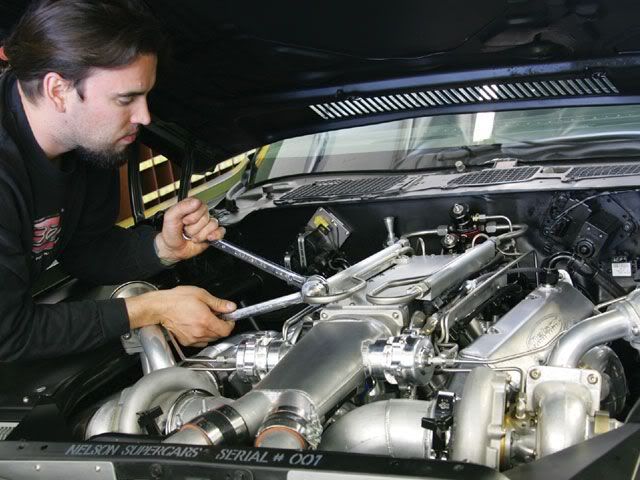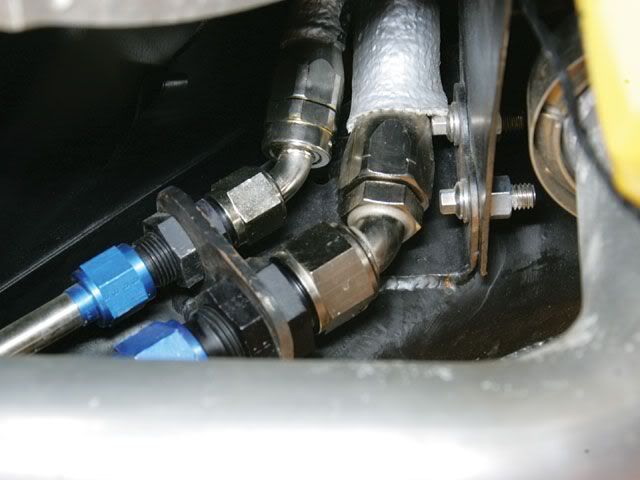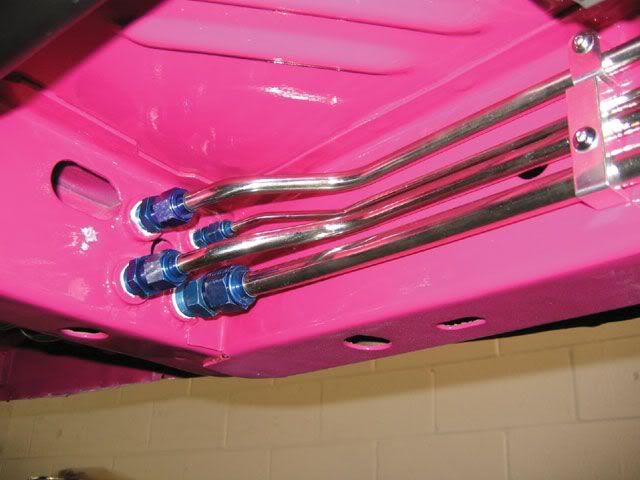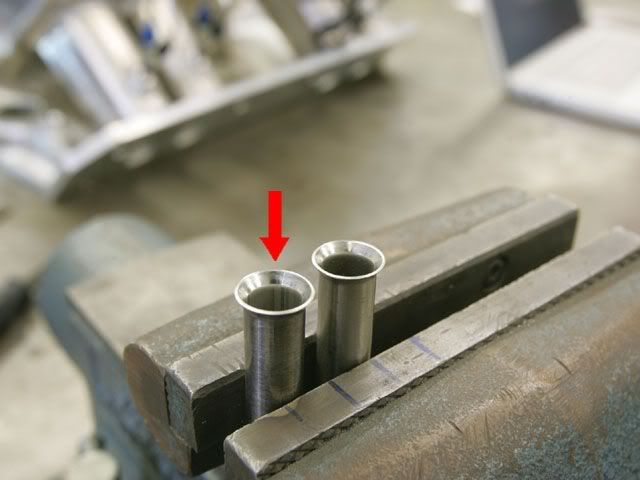From the February, 2009 issue of Hot Rod
By David Freiburger
Photography by David Freiburger, Mark Bohlen
Penultimate. It means next to last, and this is it. Our twin-turbo F-Bomb Camaro has been lingering around these pages for six issues-this month we're finally done showing you how to build it, and in the September issue we'll be able to gloriously reveal what it's like to drive the thing. For a lot of the players, that moment will culminate with one big sigh of relief. That's certainly true of Mark Bohlen, who's the last in a long line of F-Bomb craftsmen we've introduced you to.
Along with his wife, Michelle, and Twig, the ubiquitous Italian greyhound shop dog, Bohlen operates Bent Custom & Performance out of a supertidy shop that's in the same industrial complex as Nelson Supercars, the instigator of the Bomb. While Bent is a full-service fabrication shop-regularly handling minitub jobs, chassis modifications, and street rod setup-he's become known around here as the go-to guy for custom-bent hard lines for anything that carries automotive fluid or air. Applications include fuel systems, air conditioning, brakes, oil coolers, vacuum lines, airbag-suspension plumbing, and anything else you can think of.
The Bent shop creates all the hard lines for Nelson Racing Engines' twin-turbo engines, and that's how we got hooked up with Bohlen for the F-Bomb. In addition to the engine plumbing, he handled all the complex fluid conveyance systems on the chassis. Ninety percent would be hard line; flexible braided line would only be used in areas that need vibration damping, such as between the engine and frame, and in spots that require quick-release AN fittings.
The first step with hard line is to choose the material. While some racers prefer it for its light weight, Bohlen rarely uses aluminum tubing, telling us, "It's easy to bend by hand, but you can hardly ever get it perfectly straight since it always comes in rolls. It's so soft that it flattens out if you try and unbend it, and AN flares in aluminum gall up after a few times being connected or if you overtighten them. It can be polished, but it gets dull quickly." Another option is mild-steel tubing, which has the advantage of being easy to bend. Even so, Bent does not use it often because it has a seam that can be problematic, and because it cannot be polished. Bohlen's material of choice is aircraft stainless tubing, despite the fact that it is the hardest material and the most difficult to bend. However, Bohlen says, "Stainless is great because if you leave it unpolished it looks race, or the show guys can polish it and it stays shiny forever. Small dings can be polished out. It's hard enough that you can use single flares rather than the double flares that you have to do with soft mild-steel tubing. It might take more effort to make an actual bend in it, but it's cleaner to work with overall."Even so, Bohlen warns that some so-called aircraft-quality stainless tubing still has a seam inside it. He's found that the seam leaves a hard bump anytime a flare is added to the tubing, and that the imperfection can cause sealing problems at the junctions. Bent sells its own true seamless stainless tubing to avoid those problems. Bohlen typically uses 0.035-inch-wall tubing in sizes 11/42 inch in diameter and smaller, and 0.040-inch-wall for 51/48 inch and up. The thicker walls on the bigger tubing help prevent it from collapsing in hand benders, which do not have a mandrel inside them to support the i.d. of the tube as it is formed.
In all, the bending job helps the car look very orderly and purposeful, and is easier to work on than it would have been if we'd done everything in flex hose.
Bending tips

Here's Bohlen's 15-year collection of hand-benders in a number of tube sizes and jaw styles. The various brands clamp the tubing in individual ways, allowing different shapes to be formed without the bent tube interfering with the tool itself. Don't buy electrical conduit benders.
While the benders have clamps that hold the tube, Bohlen has found that he can often get the bend closer to the end of the tube-especially when a fitting is in the way-by holding the tube closer to the die using a pair of pliers with the teeth ground off of the jaws to prevent galling. Note that the bender is marked in degrees; this tube has been bent just past 90 degrees, though it will likely spring back to a clean right angle.
Here is an example of a tube bent using the normal method (top) versus one held with the pliers. Note how much closer the bend is to the end. This is also handy for getting lines parallel with each other, as shown.
Flaring tips
While some insist that you should not cut tubing with a hacksaw, Bohlen does it every day. He recommends a 32-tooth-per-inch blade and never uses a regular tubing cutter. After hacking, he squares and cleans the end of the tube with a sander, as shown, making sure not to overheat the material, which will tend to reharden the annealed stainless (weakening it).
After sanding, the end of the tube is further cleaned using two deburring tools to clean the ID and a fine file to smooth the outside.
While Bent has a trick aircraft flaring machine, tubing can also be hand-flared. This is a Ridgid single-flaring tool available at Home Depot or other hardware stores. It can be used with stainless tubing.
If you are working with mild steel, the tube must be double-flared with a tool like this that includes dies (arrow) used to fold the tube in on itself. These tools are always pretty frustrating to use.
To double-flare the mild steel, you first flare it with the die, then remove the die and advance the tool's cone-shaped bit into the mouth of the tube (arrow) to ensure a double layer of metal that helps prevent cracking.
If you have a poor seal in a tapered fitting, these soft brass tapered washers can help by making a soft surface for the taper to seat upon.
Look closely at the arrow and you can see the hard spot that is created in the tubing when you flare a stainless tube with a seam in it. The tube to the right is Bent's seamless tubing.
Remember that in the world of flares, there are two common types: 37 degrees in the AN world and 45 in the automotive and industrial hydraulic venues. Most 45-degree fittings are brass or steel, while AN is usually aluminum. It is by far best to mate 45 to 45 and 37 to 37, and stainless-to-stainless tapers need to be the most concentric because the metal is so hard. Going aluminum to stainless, you can often get away with mating 37 and 45 degrees, though the sealing surface is smaller so this is not optimal.
Tube sizes to -AN sizes
I don't think there's much to add from that. If I come across anything else, I'll amend to this.
Other links:
What are hard lines? Thread in VWVortex
Imperial flaring tool
Hard line kit made by Swoops
Copper piping - pressure rating and burst strength
http://www.airsociety.net/forums/showthread.php/281-hardlines-fittings-tools-thread
http://www.classictrucks.com/tech/0501cl_brake_line_basics/index.html
http://forums.thecarlounge.com/showthread.php?5275739-Can-ptc-fittings-be-used-on-hardlines
http://www.infamousnissan.com/forum/showthread.php?t=2357
http://www.garagejournal.com/forum/showthread.php?t=47469
http://garagejournal.com/forum/showthread.php?t=45617














No comments:
Post a Comment